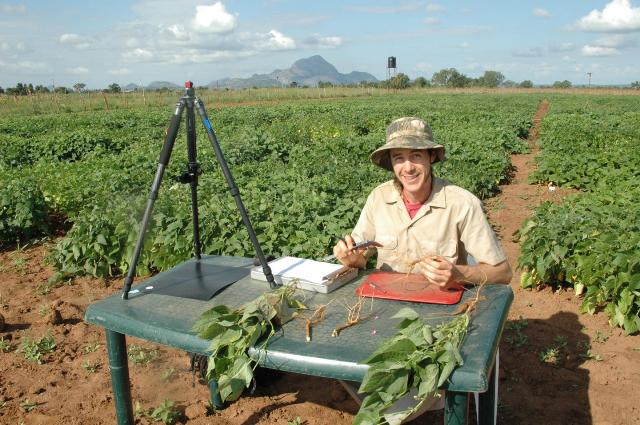Oct 10 2014
Plant scientists are working to improve important food crops such as rice, maize, and beans to meet the food needs of a growing world population. However, boosting crop output will require improving more than what can be seen of these plants above the ground. Root systems are essential to gathering water and nutrients, but understanding what's happening in these unseen parts of the plants has until now depended mostly on lab studies and subjective field measurements.
 Researcher James Burridge of Penn State University determines root phenotypes manually and with a prototype of the imaging system. Credit: Penn State
Researcher James Burridge of Penn State University determines root phenotypes manually and with a prototype of the imaging system. Credit: Penn State
To address that need, researchers from the Georgia Institute of Technology and Penn State University have developed an automated imaging technique for measuring and analyzing the root systems of mature plants. The technique, believed to be the first of its kind, uses advanced computer technology to analyze photographs taken of root systems in the field. The imaging and software are designed to give scientists the statistical information they need to evaluate crop improvement efforts.
"We've produced an imaging system to evaluate the root systems of plants in field conditions," said Alexander Bucksch, a postdoctoral fellow in the Georgia Tech School of Biology and School of Interactive Computing. "We can measure entire root systems for thousands of plants to give geneticists the information they need to search for genes with the best characteristics."
The research is supported by the National Science Foundation's Plant Genome Research Program (PGRP) and Basic Research to Enable Agriculture Development (BREAD), the Howard Buffett Foundation, the Burroughs Wellcome Fund and the Center for Data Analytics at Georgia Tech. The research was reported as the cover story in the October issue of the journal Plant Physiology.
Beyond improving food crops, the technique could also help improve plants grown for energy production, materials, and other purposes.
Root systems are complicated and vary widely even among plants of the same species. Analyzing critical root properties in field-grown plants has depended on manual measurements, which vary with observer. In contrast, automated measurements have the potential to provide enhanced statistical information for plant improvement.
Imaging of root systems has, until now, largely been done in the laboratory, using seedlings grown in small pots and containers. Such studies provide information on the early stages of development, and do not directly quantify the effects of realistic growing conditions or field variations in water, soil, or nutrient levels.
The technique developed by Georgia Tech and Penn State researchers uses digital photography to provide a detailed image of roots from mature plants in the field. Individual plants to be studied are dug up and their root systems washed clean of soil. The roots are then photographed against a black background using a standard digital camera pointed down from a tripod. A white fabric tent surrounding the camera system provides consistent lighting.
The resulting images are then uploaded to a server running software that analyzes the root systems for more than 30 different parameters – including the diameter of tap roots, root density, the angles of brace roots, and detailed measures of lateral roots. Scientists working in the field can upload their images at the end of a day and have spreadsheets of results ready for study the next day.
"In the lab, you are just seeing part of the process of root growth," said Bucksch, who works in the group of Associate Professor Joshua Weitz in the School of Biology and School of Physics at Georgia Tech. "We went out to the field to see the plants under realistic growing conditions."
Developing the digital photography technique required iterative refinements to produce consistent images that could be analyzed using computer programs. To support the goal of making the system available worldwide, it had to be simple enough for field researchers to use consistently, able to be transported in backpacks to locations without electricity, and built on inexpensive components.
In collaboration with a research team led by Jonathan Lynch, a professor of plant sciences at Penn State, the system has been evaluated in South Africa with cowpea and maize plants. With its ability to quickly gather data in the field, it was possible to evaluate a complete cowpea diversity panel. Penn State collaborator James Burridge compiled a novel cowpea reference data set that consists of approximately 1,500 excavated root systems. The data set was measured manually to validate and compare with the new computational approaches. In the future, the system could allow scientists to study crop roots over an entire growing season, potentially providing new life cycle data.
The research shows how quantitative measurement techniques from one discipline can be applied to other areas of science.
"Alexander has taken rigorous, computational principles and collaborated with leading plant root biologists from the Lynch group to study complex root structure under field conditions," said Weitz. "In doing so, he has shown how automated methods can reveal new below-ground traits that could be targeted for breeding and improvement."
Data generated by the new technique will be used in subsequent analyses to help understand how changes in genetics affect plant growth. For instance, certain genes may help plants survive in nitrogen-poor soils, or in areas where drought is a problem. The overall goal is to develop improved plants that can feed increasing numbers of people and provide sustainable sources of energy and materials.
"We have to feed an ever-growing population and we have to replace materials like oil-based fuels," Bucksch said. "Integral to this change will be understanding plants and how they provide us with food and alternative materials. This imaging technique provides data needed to accomplish this."